
The transpiration from the vegetation, Eat, depends on the density of the vegetation, (i.e. the leaf area index, LAI) the soil moisture content in the root zone and the root density. Thus,
where Eat is the actual transpiration [LT-1], f1(LAI) is a function based on the leaf area index [-], f2(q) is a function based on the soil moisture content in the root zone [-], and RDF is a root distribution function [-].
f1(LAI)
The function, f1(LAI), expresses the dependency of the transpiration on the leaf area of the plant by (see Figure 20.1)
where C1 and C2 are empirical parameters [-].
f2(q)
The second function, f2(q), is given by
where qFC is the volumetric moisture content at field capacity [-], qW is the volumetric moisture content at the wilting point [-], q is the actual volumetric moisture content [-] and C3 is an empirical parameter [LT-1].
As illustrated in Figure 20.2, higher values of C3 will lead to higher values of transpiration, which means that the soil will dry out faster, assuming all other factors constant. In a simulation, the actual transpiration will decrease more quickly for larger values of C3.
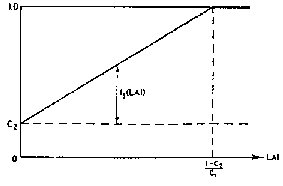
Figure 20.1 The function f1 versus LAI.
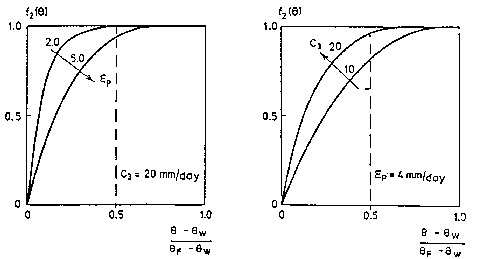
Figure 20.2 The soil moisture function f2(q) for constant C3 (20 mm/day) and varying Ep (left), and for constant ETref (4 mm/day) and varying C3 (right).
Root Distribution Function, RDF
Water extraction by the roots for transpiration varies over the growing season. In nature, the exact root development is a complex process, which depends on the climatic conditions and the moisture conditions in the soil.
Thus, MIKE SHE allows for a user-defined, time-varying root distribution determined by the root depth (time varying) and a general, vertical root-density distribution, see Figure 20.3.
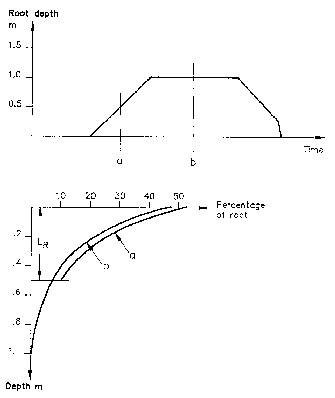
Figure 20.3 Root distribution in time and with depth.
The root extraction is assumed to vary logarithmically with depth by (see Figure 20.3)
(20.7) 
where Ro is the root extraction at the soil surface, AROOT is a parameter that describes the root mass distribution [-], and z is the depth below ground surface [L].
The value of the Root Distribution Function, RDF, in each layer is then calculated by dividing the amount of water extracted in the layer by the total amount of water extracted by the roots. Thus,
(20.8) 
where the numerator is the total amount of water extracted in layer i bounded above by Z1 and below by Z2 and the denominator is the total amount of water extracted by the roots between the ground surface and the maximum root depth, LR.
How the water extraction is distributed with depth depends on the AROOT parameter. Figure 20.4 shows the distribution of transpiration for different values of AROOT, assuming that the transpiration is at the potential rate with no interception loss (Cint=0) and no soil evaporation loss (C2=0). The figure shows that the root distribution, and the subsequent transpiration, becomes more uniformly distributed with depth as AROOT approaches 0. During simulations, the total actual transpiration tends to become smaller for higher values of AROOT because most of the water is drawn from the upper layer, which subsequently dries out faster. The actual transpiration, therefore, becomes more dependent on the ability of the soil to conduct water upwards (capillary rise) to the layers with high root density.
Figure 20.5 shows the effect of the root depth, given the same value of AROOT. A shallower root depth will lead to more transpiration from the upper unsaturated zone layers because a larger proportion of the roots will be located in the upper part of the profile. However, again, this may lead to smaller actual transpiration, if the ability of the soil to conduct water upwards is limited.
Thus, the factors AROOT and root depth are important parameters for estimating how much water can be drawn from the soil profile under dry conditions.
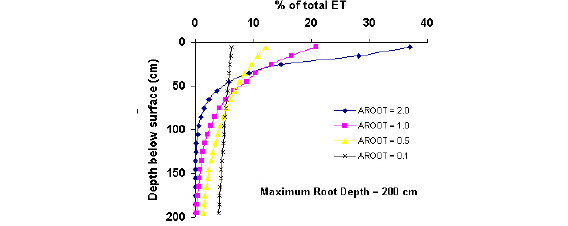
Figure 20.4 Fraction of ET extracted as a function of depth for different values of AROOT.
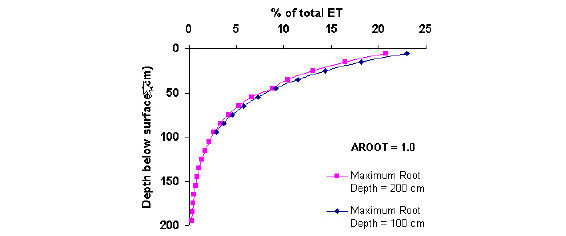
Figure 20.5 Fraction of ET extracted as a function of depth for different maximum root depths.
ET distribution between UZ and SZ
Evapotranspiration is extracted from saturated groundwater only when the roots are in contact with the water table - that is, when the root zone is connected to the water table. This can happen in two ways.
· The first is when the water table is physically in the root zone. In most natural systems this will only occur temporarily. If the roots are submerged for any length of time the roots will be starved of oxygen and drown.
· More commonly, the roots reach the capillary fringe. In this case, the evapotranspiration from the capillary fringe is replaced by water from the saturated zone.
In both cases the Kristensen and Jensen method calculates the ET from the subsurface. The MIKE SHE UZ module distributes this ET between the UZ and SZ cells.
In the first case, the ET is simply divided between the UZ and SZ depending on the fraction that would be removed from UZ cells that are below the water table.
In the second case, Richards Equation takes care of the natural replacement of water from the saturated zone by capillarity. However, the Gravity Flow method will ignore capillarity and the lower root zone may become too dry.